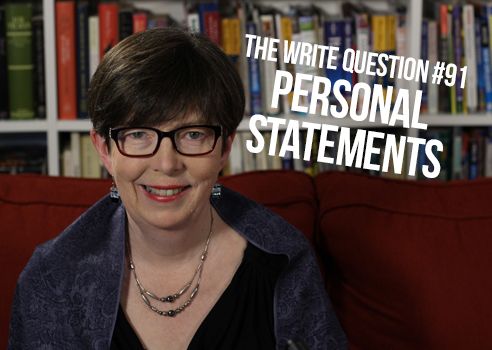Viewing time: 5 mins. 55 secs.
The Write Question is a weekly video podcast about writing that I started in 2017 and that ran, more or less weekly, until April 2022. This is a republication of issue #91, which addresses how to write a personal statement. The post first ran on May 17/19.
Transcript:
Welcome to The Write Question, I’m Daphne Gray-Grant and my topic today is how to write a personal statement for university.
I have an question from Maria Ramirez, a potential student based in Reston, Virginia. Here’s what she’s asked:
“I’m a native Spanish speaker and next month I will be taking a court-Spanish interpreter program with the University of Delaware. The university is asking me to write a personal statement about what motivates me to take this program. I have some ideas but don’t know where to start. Could you give me some tips on how to write a personal statement?”
Thanks for your question, Maria. Writing a personal statement might sound daunting, but keep in mind that it presents you with a great opportunity.
Instead of being evaluated on grades alone, you have the chance to let the admissions team understand WHY you want to get into this program, what unique qualities you have to offer them and what makes you tick. Also, if you’re invited to attend an interview, your statement gives you the chance to influence the questions you will be asked, which will make the interview go more smoothly.
But that’s down the road. Let’s talk about now.
Start by finding out the precise word count you’re allowed. There’s no point writing anything until you have a goal. If the university won’t give you one, set that goal for yourself. In the absence of other guidelines, I think 500 words is a good length.
Next, do a mindmap. Mindmaps are great for brainstorming and for inspiring you to write. They’re way better than outlines because they don’t demand that you to put anything in a particular order. This makes them more fun and more inspirational. I’ve written a lot about mindmaps on my website and I’ve included a couple of links below. Once you have the mindmap done, start writing.
Understand that writing is going to be way easier if you separate it from editing. Don’t ever try to edit WHILE you’re writing. Instead, do it later. I’ve included a link below to a blog post on that topic. You’re not going to get your personal statement 100% right on the first attempt, so you shouldn’t try to do that. Instead, work to get what I like to call a crappy first draft, link below, as quickly as possible.
Here is some information you should consider including in your personal statement:
- Why you want to take the program
- Why you’re a good fit for it.
- What external activities you’ve done that make you a good choice for it. By the way, be sure to explain why these activities are relevant for your program. Don’t say, “I played the piano for 10 years.” Instead describe the qualities those piano lessons instilled in you: perhaps, determination, persistence and attention to detail.
- Your long-term plans. WHY do you want to get into this program in the first place? How will you be giving back to society as a result.
- Any unusual obstacles or hardships you’ve had to overcome.
Students are often daunted by writing statements like this and many of them focus on developing a flashy or gimmicky beginning. This is almost always a mistake. Admissions officers have seen it all before. Begin simply and honestly and get to the point very quickly. All you have is 500 words. Don’t waste 250 of them on a jazzy beginning.
Once you have your crappy first draft, then concentrate on honing it, making it better. Here’s how I suggest you do that:
Read it aloud, slowly, pretending you don’t know anything about yourself. Pause after reading the first sentence and ask yourself whether you would want to continue reading if you were a total stranger. If your answer is no, go back and rewrite it. But, if that sentence passes the first test, then ask yourself if it raises any questions in your mind. If it does that’s okay but then make sure the second sentence answers them!
Read through the entire piece in this start-and-stop fashion until you are convinced the letter is interesting, informative and highly readable.
Once you’ve achieved this objective, then you move on to what is called copy editing. This means looking for — and eliminating — clichés, spelling mistakes and wordy language. I’ve included a link below on how to do this type of editing.
Note that editing is a big job and you should expect it to take you at least twice as long as it took you to write the letter in the first place.
Of course it goes without saying that your letter mustn’t have a single typo or spelling mistake in it. Get several friends and family members to help proofread it for you to make sure it is perfect.
Finally, let me wrap up with a quote from Nelson Mandela, “Education is the most powerful weapon which you can use to change the world.”
Maria, writing a personal statement, can be daunting when you desperately want to get into a particular school. Don’t freak yourself out. Just start early and give yourself plenty of time for diligent editing. If you do that, odds are high you’ll get your own chance to change the world.
LINKS
How to create a mindmap (video)
How can I solve a mindmapping block (video)
7 ways to stop editing while you write


